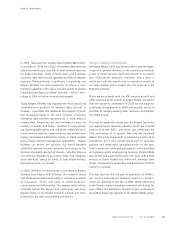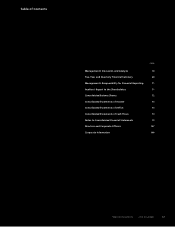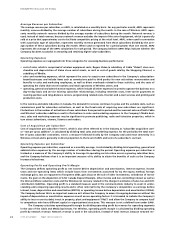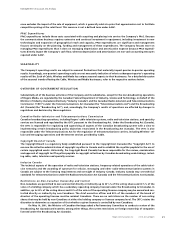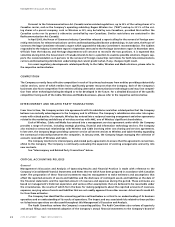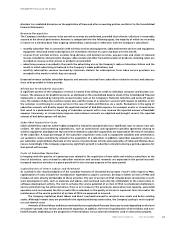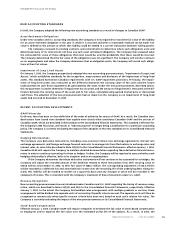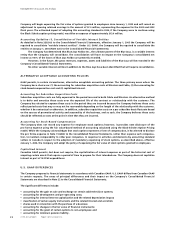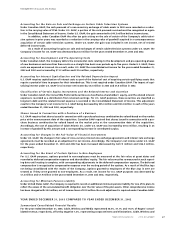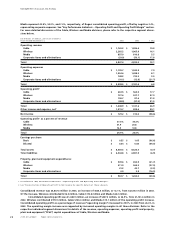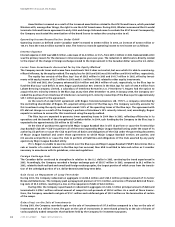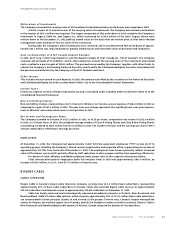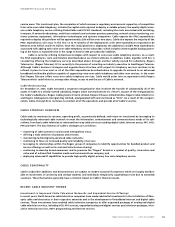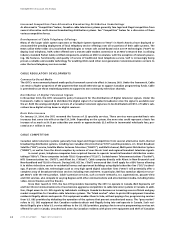Rogers 2003 Annual Report Download - page 27
Download and view the complete annual report
Please find page 27 of the 2003 Rogers annual report below. You can navigate through the pages in the report by either clicking on the pages listed below, or by using the keyword search tool below to find specific information within the annual report.
2003 Annual ReportRogers Communications Inc. 25
NEW ACCOUNTING STANDARDS
In 2003, the Company adopted the following new accounting standards as a result of changes to Canadian GAAP:
Asset Retirement Obligations
Under new Canadian and U.S. accounting standards, the Company is now required to record the fair value of the liability
for an asset retirement obligation in the year in which it is incurred and when a reasonable estimate can be made. Fair
value is defined as the amount at which that liability could be settled in a current transaction between willing parties.
The Company reviewed its existing contracts and commitments to determine where such obligations exist and
determined many of its contracts do not have any such asset retirement obligations. The Company then assessed what
the estimated fair value of those obligations that exist would be, and the probability that these would be incurred.
The Company determined that the fair value of the obligations was not significant. The Company will monitor contracts
on an ongoing basis and when the Company determines that an obligation exists, the Company will record such obliga-
tions at their fair values.
Impairment of Long-Lived Assets
On January 1, 2003, the Company prospectively adopted the new accounting pronouncement, “Impairment of Long-Lived
Assets,” which establishes standards for the recognition, measurement and disclosure of the impairment of long-lived
assets. This standard harmonizes Canadian requirements with U.S. GAAP impairment provisions. Previously, the impair-
ment of long-lived assets was measured as the difference between the carrying value of the asset and the future
undiscounted net cash flows expected to be generated by the asset. Under the new pronouncement, described above,
this measurement is used to determine if impairment has occurred, and the amount of impairment is measured as the dif-
ference between the carrying value of the asset and its fair value, calculated using quoted market price or discounted
cash flows. The adoption of the new pronouncement had no impact on the Company as no impairment of long-lived
assets had occurred at December 31, 2003.
RECENT ACCOUNTING DEVELOPMENTS
GAAP Hierarchy
Until now, there has been no clear definition of the order of authority for source of GAAP. As a result, the Canadian stan-
dard setters have issued new standards that explain more clearly what constitutes Canadian GAAP and the sources of
Canadian GAAP, which are described in Note 2((t)(v)) to the Consolidated Financial Statements. This standard is effective for
the Company’s 2004 fiscal year, and results in “industry practice” no longer being a justification for a particular accounting
policy. The Company is currently evaluating the impact of the adoption of the new standards on its Consolidated Financial
Statements.
Hedging Relationships
The Company uses derivative instruments, including cross-currency interest rate exchange agreements, interest rate
exchange agreements, and foreign exchange forward contracts, to manage risks from fluctuations in exchange rates and
interest rates. As more fully described in Note 2((t)(ii)) to the Consolidated Financial Statements, effective January 1, 2004,
Canadian GAAP will require the Company to maintain detailed documentation regarding these derivative financial instru-
ments in order to continue accounting for these as hedges. Further, the Company will be required to assess whether each
hedging relationship is effective, both at its inception and on an ongoing basis.
If the Company determines that these derivative instruments will not continue to be accounted for as hedges, the
Company will adjust the recorded amount of the liabilities related to these instruments from their carrying value of
$334.8 million at December 31, 2003, to their fair value of $388.2 million. The corresponding adjustment of $53.4 million
will be recorded as a deferred loss and amortized into income over the remaining life of the underlying debt. Going for-
ward, this liability will be marked to market on a quarterly basis and any changes in value will be recorded in the
statement of income. This is consistent with the Company’s treatment of these instruments under U.S. GAAP.
Revenue Recognition
New accounting pronouncements were introduced under Canadian and U.S. GAAP regarding the timing of revenue recog-
nition, which are described in Notes 2((t)(i)) and 22(r) to the Consolidated Financial Statements, respectively. Effective
January 1, 2004, to the extent the Company has bundled sales arrangements with multiple products or services, these
arrangements will be divided into separate units of accounting if specific criteria are met. The separate units will then be
recognized as revenue only when specific revenue criteria have been met, based on each unit’s relative fair value. The
Company is currently evaluating the impact of the new pronouncements on its Consolidated Financial Statements.
Stock-Based Compensation
Effective January 1, 2004, Canadian GAAP will require companies to estimate the fair value of stock-based compensation
to employees and to expense the fair value over the estimated useful life of the options. As a result, in 2004, the
Management’s Discussion and Analysis


